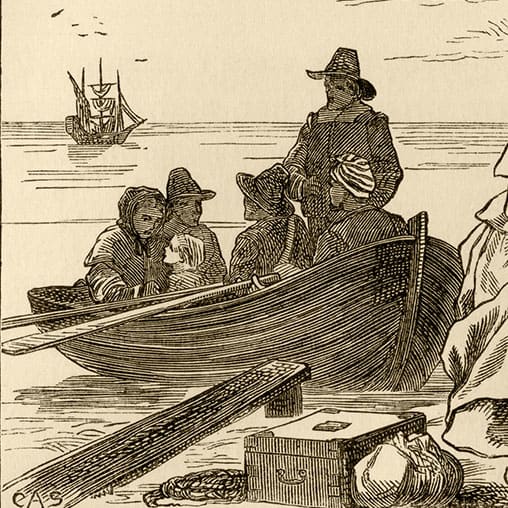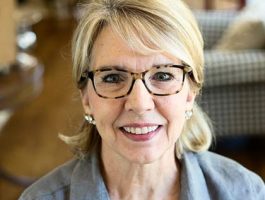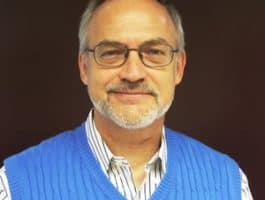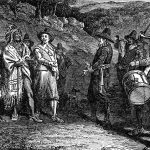
Remembering the Pilgrims
Pilgrims. Who were they, really? Tracy McKenzie, professor of history at Wheaton College, and Barbara Rainey take us back to the 1600s to the village of Scrooby, the birthplace of a sect of the Puritans called the Pilgrims. It was here, they tell us, that the Pilgrims first planned their exodus from England to Holland, and eventually, Massachusetts. Find out more about these people and their incredible journey.
Show Notes
About the Guest
-
Pilgrims. Who were they, really? Tracy McKenzie, professor of history at Wheaton College, and Barbara Rainey take us back to the 1600s to the village of Scrooby, the birthplace of a sect of the Puritans called the Pilgrims. It was here, they tell us, that the Pilgrims first planned their exodus from England to Holland, and eventually, Massachusetts. Find out more about these people and their incredible journey.
-

Barbara Rainey
After graduating from the University of Arkansas with a Bachelor of Arts degree in history, Barbara joined the staff of Cru® in 1971. With her husband Dennis, whom she married in 1972, the Rainey’s cofounded FamilyLife®, a ministry committed to helping marriages and families survive and thrive in our generation. Barbara is a frequent speaker and guest on FamilyLife Today®, FamilyLife’s award-winning nationally-syndicated daily radio broadcast. She is the author or coauthor of...more
Tracy McKenzie
Robert Tracy McKenzie (Ph.D., Vanderbilt University) is professor and chair of the department of history at Wheaton College, where he teaches courses in U.S. history, the Civil War and historiography. McKenzie is the author of two award-winning monographs: "One South or Many? Plantation Belt and Upcountry in Civil-War Era Tennessee" (Cambridge, 1994) and "Lincolnites and Rebels: A Divided Town in the American Civil War" (Oxford, 2009). He has also written numerous scholarly reviews and articles...more
Tracy McKenzie and Barbara Rainey take us back to the 1600s to the village of Scrooby, the birthplace of a sect of the Puritans called the Pilgrims.
Remembering the Pilgrims
Bob: When the first Pilgrims came to America, traveling from Europe to New England, their passage on the Mayflower was not a comfortable one. Here’s Professor Tracy McKenzie.
Tracy: The Pilgrims, 102 of them, would have spent most of the journey in what was called the ‘tween decks, which was an area between the hold and the bottom. It’s an area that you cannot even stand up in—it’s only about four-and-a-half feet high. In area, in terms of square feet, I would liken it to about one-half the size of a modern-day basketball court.
So let’s imagine an area—one-half of a basketball court / four-and-a-half feet high—102 people crowded into that area for 65 days, while they make progress across the ocean at a rate of two miles per hour.
Bob: This is FamilyLife Today for Thanksgiving Day in the United States, Thursday November 23rd. Our host is the President of FamilyLife®, Dennis Rainey, and I’m Bob Lepine. A little history lesson today as we talk about the very first Thanksgiving and separate the legend from the reality. Stay with us.
1:00
And welcome to FamilyLife Today. Thanks for joining us on Thanksgiving Day, here, in the United States. I’m sure you’ve heard this riddle before, but I’ll ask anyway: “If April showers bring May flowers, what do May flowers bring?”
Dennis: Thunderstorms?
Bob: No, no, no, no, no! Pilgrims! [Laughter] Get it? You’ve heard that before; haven’t you?
Barbara: Yes, yes, yes.
Tracy: Yes.
Dennis: It’s been a long time since I heard that. Well, we’re joined today by my wife, Barbara—welcome back—
Barbara: Thanks. I’m glad to be here.
Dennis: —to FamilyLife Today—and by Dr. Tracy McKenzie. Tracy, welcome to the broadcast.
Tracy: Thank you. I’m glad to be here.
Dennis: Tracy has written a book; and I feel like we’re going to go to school, Bob. This is going to be fun. Between Barbara and Tracy, we’re going to get some education about the first Thanksgiving, which is the title of Tracy’s new book.
2:00
It is subtitled: What the Real Story Tells Us About Loving God and Learning from History. I love that subtitle—I really do like it. He is a graduate—has his PhD—from Vanderbilt and is Professor and Chair of the Department of History at Wheaton College.
This book is about the first Thanksgiving—you say, as any good history professor would, that a thorough examination of the evidence is the basis of good history. What kind of evidence do we have for the Pilgrims?
Tracy: Great question, Dennis. The reality is that we don’t have a lot of evidence. One of the things I always tell students is, when we’re thinking about this event that we call the first Thanksgiving, the reality is there is a sum total of 115 words that have survived about that event.
3:00
So, it’s a very meager amount—sort of a paragraph or so. We have to piece together lots of clues from different sources. When we do that, we’re primarily drawing on a couple of documents that really have had sort of an extraordinary history. One is an account that was actually contained in a letter sent to England in 1621. It was published in part of a pamphlet in 1622 and then vanished. It only resurfaced about two centuries later in the 1830s.
The other is a history of the Plymouth Colony, written by its long-time governor, William Bradford. Bradford wrote this history, really, for his descendants. He kept a sort of a—almost a secret kind of history that he didn’t circulate. He passed it down through the generations, and then we think it was probably taken by Revolutionary British soldiers during the American Revolution. At any rate, it disappeared and only turned up in the library of the Bishop of London in 1851; then it was published in the 1850s.
So we have these two documents that really vanished for two centuries—turned up in the middle of the 1800s.
4:00
Taking clues from both of them together, we can sort of piece together what we think the event looked like.
Bob: So, if I went back to America in 1810—there was no Thanksgiving celebration—maybe not even any legend about this meal between the Pilgrims and the Indians?
Tracy: Good question, Bob. There would have been thanksgiving celebrations; absolutely! In fact, it’s a tradition that was pretty widespread in New England and had been since the late 1600s; but it wasn’t linked to a single event in 1621. It wasn’t remembered as continuing a tradition that was begun by this group of passengers on the Mayflower. So, in that respect, the idea of a “first Thanksgiving” wasn’t on the American radar. For all practical purposes, as late as 1840, it was as if it had never happened.
5:00
Dennis: Well, I have to say—as someone who did not appreciate history when I was a young man in school—that I married someone who did. In our family, Barbara brought the story of Thanksgiving and the story of the Pilgrims to our family, which we began to celebrate. At that point, I really began to appreciate some of the backstory of the Pilgrims getting to America, which we do know a good bit about that, and how Barbara began to explain that to our children. Explain, Barbara, what we used to do when we had a crowd of kids at the table there on Thanksgiving morning. Share how you helped our family become very intentional about celebrating Thanksgiving.
Barbara: Well, I wanted to help correct some of the errors that I felt like my children were receiving at school. They weren’t learning all the real story and I knew I didn’t know all the real story; but I knew I knew some things that they didn’t. Especially what I wanted our children to learn was—
6:00
I wanted them to understand and appreciate the faith of these Pilgrim passengers on the Mayflower, who came over and risked everything—so many of them died. They had incredible hardship; and, yet, in the midst of it, we see them giving thanks and praising God for their circumstances. I wanted my kids / I wanted our kids to know that because—when you see someone, who has difficult circumstances, but they’re giving thanks to God in the midst of it—it inspires us to do the same.
Dennis: Yes.
Barbara: And so, to help our children grow in gratitude, I wanted them to see somebody—who lived in much more difficult circumstances, who still were giving thanks—so that our children might be inspired to be a little bit more grateful. So, that was kind of the genesis of it. I found some of these stories. We just began to read them on Thanksgiving morning as a way to kind of focus a little bit on the history of the event and to focus on gratitude before we began to feast, and play football, and do all of the things that we commonly do today.
7:00
Dennis: Tracy, you may not know this, but Barbara drug me to Plymouth, where there is a great exhibit / a museum that celebrates the lives of these spiritual heroes. You were sharing—as we walked into the studio—that you stood there, near a graveyard, that really does represent these Pilgrims and who they are. You said you got emotional about it; because you knew who they were, you knew what they had done, and you so admired their heroism.
Tracy: That’s exactly right, Dennis. If anyone has opportunity to go to Plymouth, I would recommend that today. There’s both a living history museum, where there’s an effort to recreate the early settlement as it might have looked around 1627 or so; but there’s also the actual spot where the original settlement was built—it’s now the sight of a cemetery.
8:00
There’s a marker there that shows where the combination fort/meeting house would have stood. I can remember standing there, among the gravestones, and looking out down toward the bay—and seeing the water in the distance—and thinking about all that had transpired there. It was a profoundly moving experience.
One of the things I feel, as a historian / as a Christian historian is that American Christians today, largely, are stranded in the present. We really don’t think of ourselves as being part of a church that—not only transcends cultures, tribes, and nations—but transcends generations and ages. When we gather around the throne, at future time, we’ll be seeing a church that spans centuries as well as cultures. So, at a place like Plymouth, you really have that sense of connection with those who have gone before that is both convicting and encouraging.
Dennis: To that point, explain who the Pilgrims were as you’ve studied them; because you’ve got some unique insights to these men and women.
9:00
Tracy: Well, we just start with an understanding the Pilgrims are part of, in a sort of sense, a broader phenomenon that’s going on in the late 1500s and early 1600s in England. They’re Protestants. They believe that the Church of England—the Anglican Church, we might call it—has broken, in part, from the Roman Catholic Church but not sufficiently—that the Anglican Church has retained things that they’re not convinced are really pointed to in Scripture. There’s the hierarchy of priests and bishops / there are some ceremonies and rituals that they don’t believe the Scripture calls for.
So they have called for the church to be purified; but, ultimately, they arrive at the conclusion—at least, the genesis of the Pilgrims—they arrive at the conclusion that the Anglican Church is really a church that they can no longer fellowship with in good conscience. They begin to really separate. We speak of the Pilgrims as part of a group of Separatists, who are really a subset of English Protestants or Puritans.
10:00
Ultimately, in separating from the established church, they’re both defying the church and the government; because—
Dennis: So, they’re radicals!
Tracy: They are absolutely radical. We need to think of Puritans as radicals and Separatists as the most radical of radicals—so they’re meeting in secret / they are running great risks to do so. Ultimately, around 1607/1608, they begin to reach the conclusion that they really aren’t safe to stay in the area where they are, north of London.
So, at that point—1608—this is part of the story that we often, I think, forget—they leave England, but not for the Americas. They leave for Holland. They are there, in fact, for about 12 years or so. Their migration is actually a two-stage migration. They’ll spend 12 years in Holland and then, in 1620, they’re going to come to what is ultimately Massachusetts.
What they ultimately decided to do, I think, is so instructive to us. They did not say, as individuals or as individual families:
11:00
“Hey, this is not a good situation. We have to go elsewhere.” They said, “We have to do something that allows our church, as a congregation, to continue to exist as a body.” So, ultimately, when they come to Massachusetts, they’re trying to relocate their congregation. They’re looking for an environment where there will be more economic opportunity; where there will be less cultural obstacles; where their church will continue, as a body, to thrive.
Dennis: Every year, when Barbara would pull out this story and she would read it or give me the book and show me the passages to read, I would get emotional—I really would—as we talked about this journey these people made on the Mayflower, and the conditions onboard, and how close they came to perishing on a number of occasions.
Give our listeners some idea of the obstacles they overcame, because many of them were life-threatening.
12:00
Tracy: Absolutely! So this voyage of the Mayflower, which we usually have some recollection of, is one of the extraordinary moments, I think, in early American history. We start with just the nature of the ship itself. If you do have a chance to go to Plymouth today, you’ll see a more or less accurate re-creation/reconstruction of that vessel.
I don’t know if any of you are baseball fans, but I like to think in these terms—the Mayflower—it’s keel, which is the beam that ran at the bottom of the ship, from the front to the back of the ship / 64 feet long—that’s roughly from the pitcher’s mound to home plate. At its highest point above the water line—from the poop deck to the stern—it’s 113 feet or so—that’s not quite the distance from home plate to second base. The Pilgrims, 102 of them, would have spent most of the journey in what was called the ‘tween decks, which was an area between the hold and the bottom in the upper deck.
Dennis: Yes.
13:00
Tracy: It’s an area that you cannot even stand up in—it’s only about four-and-a-half feet high. In area—in terms of square feet—I would liken it to about one-half the size of a modern-day basketball court. Let’s imagine an area—one-half of a basketball court / four-and-a-half feet high—102 people crowded into that area for 65 days while they make progress across the ocean at a rate of two miles per hour.
In that environment—we can imagine just what a really, in many senses, loathsome kind of environment—very little ventilation, there are storms raging, and they have to keep all of the windows and openings closed. One lady is going to give birth along the way. It’s just an environment that’s very difficult for us to even relate to.
Bob: You’re talking about nine weeks, basically, onboard. This is not—they didn’t all pull up to an island and all get off and stretch their legs and sightsee. [Laughter]
Tracy: No; no.
They arrive on the coast of present-day Cape Cod.
14:00
Dennis: Well, before we get to that—
Tracy: Okay; fair enough.
Dennis: —I’ve just got to read—this is the part where I get choked up: “About two weeks out to sea, there was a sailor who unexpectedly developed a raging fever. Within just one day, he died of an unknown sickness, raving and cursing as he breathed his last. His shrouded body was buried at sea. This sobered the other seamen. A superstitious group, even in normal circumstances, they wondered if their fellow crewman had died because of his treatment of the Pilgrims.”
It goes on to talk about how they had gauged a storm that had 50-mile-an-hour winds / waves 40/50 feet high. You can just picture those cramped quarters as you did a great job of describing it.
15:00
That’s the kind of story we read on Thanksgiving morning to bring our children into the experience / the word pictures of what these human beings endured on behalf of their faith. Their faith was real—this was not some stale doctrine or dogma. They were on a spiritual mission.
Tracy: That’s very well-put. I cannot relate to the kinds of dangers and challenges that they were willing to risk. It says something—I’m sure it says something—about the kind of commitment that they are expressing—it’s not abstract / it’s not hypothetical.
Dennis: And so, when they saw land—I mean, it was a big deal.
Tracy: It is a big deal. William Bradford, in his history of Plymouth Plantation, tells us that they immediately fall to their knees; and they praise the Lord for bringing them across that ocean and for bringing them in sight of a future home.
At that point, I should say, there’s so much drama to the Pilgrims’ story. We bring them across the Atlantic and all that is involved in that.
16:00
In a certain sense, if this were a play we were writing today, we’d say, “Alright; that moment of tension is passed and now everything is sort of going to be more and more positive from that point on.” But it’s just a story of one unexpected trial after another.
When they get on the coast of present-day Cape Cod, first of all, they find an environment that’s not at all what they were expecting. This is part of the story that really surprised me when I first came across it. They really had expectation that the area where they were going was going to be lush and almost tropical. [Laughter] That sounds—that really is—it will make us laugh. We think, “How could they be so confused?” Well, what I would challenge you to do is go to a globe or go to a map and look at the lines of latitude. The reality is that Boston, Massachusetts, is on the same line of latitude as Madrid, Spain; alright? It’s because of the nature of the currents in the Atlantic that they were expecting that the climate would be like Madrid. But Madrid is warm because it’s getting water from the Caribbean, basically.
So, when they come to Massachusetts, they find this very cold and forbidding environment.
17:00
Of course, it’s early November—so they’re on the cusp of winter. It’s not at all what they expected. They’re actually going to spend weeks trying to decide, “Is this really where we want to permanently plant our new community?” In fact, many weeks will pass—it’s going to be three days before Christmas before they can hit upon a place to stay.
They ultimately choose this place of Plymouth. Plymouth itself is not an ideal location—the harbor is very shallow. What that means is that, when they drop anchor, they have to drop anchor almost a mile from the coast. Compounding things—the longboat that they’d brought with them—they had to disassemble to be able to find a place to store it in the boat. They couldn’t immediately repair it, which meant that the way they went ashore was wading. So, they’re going to wade through frigid waters in late December more than a mile to reach the coast.
The reality is—we suspect that was the main cause of death for so many of them that died.
18:00
William Bradford, years later, as he’s keeping a record, trying to remember the experiences, he makes a list of what he calls all of the “birth and deceasing of the passengers.” He writes the cause of death as best he knows it or something about the circumstances. What you’ll see in those entries—time after time after time—is “died shortly after coming ashore.” Historians speculate that they’re just—they are exposed to brutal kinds of conditions, and they succumb to pneumonia probably more than any other single cause very quickly.
Dennis: And they had no shelter, at that point.
Tracy: They had no shelter—so they’re either staying on the shipboard or they’re basically out in the open.
Bob: At some point, I have to think somebody raised their hand and said: “Maybe this wasn’t such a good idea. I mean, can’t we get on the boat and go back to Holland? At least, we had a place to stay in Holland.” [Laughter]
Tracy: That’s a great question, Bob. And here, again, is one of those moments of drama. During this period, from late December until springtime, they really don’t have a lot of choices. They’re stuck, and they have to make the best of it.
19:00
But in early spring of 1621, the Mayflower, which didn’t belong to the Pilgrims—they basically, in a certain sense, had been leasing it or renting it—the Mayflower and its crew are going to return to England.
Any one of the Pilgrims who had wished might have joined them. The remarkable testimony there—by this point, 50 out of 102 of the original passengers—only 50 have survived. Not a single one of them is going to return to England. They’re casting their lot in this new land.
Bob: Do we know why? Do we know why they didn’t just high-tail it back home?
Tracy: Well, William Bradford doesn’t speak a great deal except I think he conveys the idea that they had entered into a covenant with one another, and they took that in the most serious sense; and they were there. In fact, one of the things that the Leiden Congregation would do is to enter into a church covenant that they would repeat regularly. I’ll just share some of the words of that. They pledged themselves—“…to join themselves by covenant of the Lord, into a church estate and the fellowship of the Gospel, to walk in all His ways made known, or to be made known to them, whatever it should cost them, the Lord assisting them.”
20:00
That was a covenant that they had entered into, and I think we see them honoring that covenant.
Dennis: I’m sitting here, listening to you, in a beautiful way, describe these men, and women, and young people, who braved the elements on behalf of their faith and, literally, laid their lives down on behalf of their convictions to come to this land. Ultimately, it was that kind of resolve that we, today, as followers of Christ, still go to the bank on. I mean, this country was formed by radical followers of Jesus Christ; right?
Tracy Well, what we have in the example of the Pilgrims is an example—at the very least, we have an example of people who share our faith / who name the same name of Jesus Christ as Lord, who were modeling for us a kind of amazing courage and self-sacrifice.
21:00
As a Christian, when I think about them, what I see is—I see a brother or sister across the generations in another time and place that is modeling for me what it means to follow Christ faithfully in the most arduous kinds of circumstances.
Dennis: And I think the question for each one of us, as we kind of turn our sights toward Thanksgiving this year, is to use the Thanksgiving table as a time—yes, to reflect back over the past year and perhaps to the past decade of how God has been good to us—but to ask the question: “What is my faith costing me? What am I sacrificing for the Savior? How are we, as a family, taking up our cross and following Christ in this era?”
By the way, this is not a theoretical question I’m asking here. This is a question we better be ready to answer because, in this culture, I think our faith is going to cost us, moving forward.
22:00
Bob: Yes; I think there’s a lot we can learn from the heroism, and the faith, and the convictions that the Puritans had that brought them to America. In fact, I think a lot of families would benefit from reading Dr. McKenzie’s book, The First Thanksgiving: What the Real Story Tells Us About Loving God and Learning from History. It’s a book we’ve got in our FamilyLife Today Resource Center. I’m thinking of a lot of families, who are thinking, “Well, I wish I had that a couple of weeks ago.”
Well, buy it now and put it aside for next Thanksgiving; and use that as a part of how you train your kids. In fact, if I still had high school kids at home, I would give them Dr. McKenzie’s book in November, and I would pay them to do a book report on this book. We used to do that all of the time—our kids loved the money, and I loved making sure they were reading the right stuff.
23:00
Again, the title of the book is The First Thanksgiving: What the Real Story Tells Us About Loving God and Learning from History. You’ll find it when you go, online,at FamilyLife Today.com
We also have copies of the book Barbara has written called Thanksgiving: A Time to Remember. Both are great books. Go online at FamilyLifeToday.com to find out more, or you can order from us online as well.
Now, here on Thanksgiving, we just want to say how thankful we are for those of you who are partners us, here, at FamilyLife—those of you who share our burden to see marriages and families strengthened to effectively develop godly marriages and families—that’s our goal / our mission, here, at FamilyLife. We could not do it if there were not folks, like you, who said, “That goal is important, and we want to be a part of the mission of FamilyLife Today.” Your donations make it possible for this ministry to be expanded / to be heard by more people more often.
24:00
We’re thankful for those of you who have been faithful friends of this ministry—long-time listeners, who are also donors, and especially our Legacy Partners, who give each month. We hope you have a great Thanksgiving celebration today. We want you to know we appreciate you, and we’re thankful for you.
And we hope you can join us back tomorrow when we’re going to talk more about the very first Thanksgiving. I know the holiday will be over, but it’s still a good day to reflect on the heritage of Thanksgiving. I hope you can tune in for that.
I want to thank our engineer today, Keith Lynch, along with our entire broadcast production team. On behalf of our host, Dennis Rainey, I'm Bob Lepine. We will see you back next time for another edition of FamilyLife Today.
FamilyLife Today is a production of FamilyLife of Little Rock, Arkansas.
Help for today. Hope for tomorrow.
We are so happy to provide these transcripts to you. However, there is a cost to produce them for our website. If you’ve benefited from the broadcast transcripts, would you consider donating today to help defray the costs?
Copyright © 2017 FamilyLife. All rights reserved.
1
Episodes in this Series


